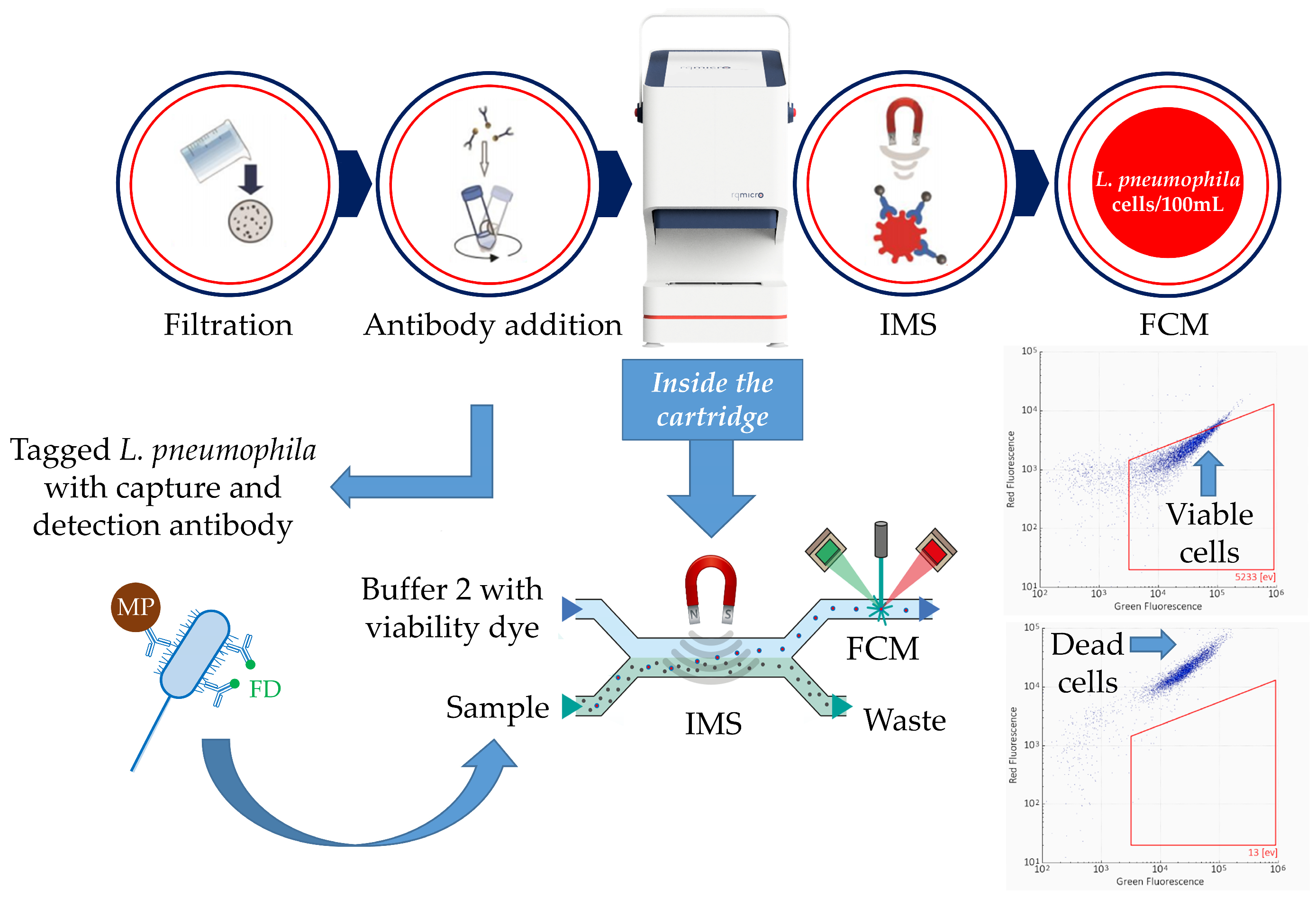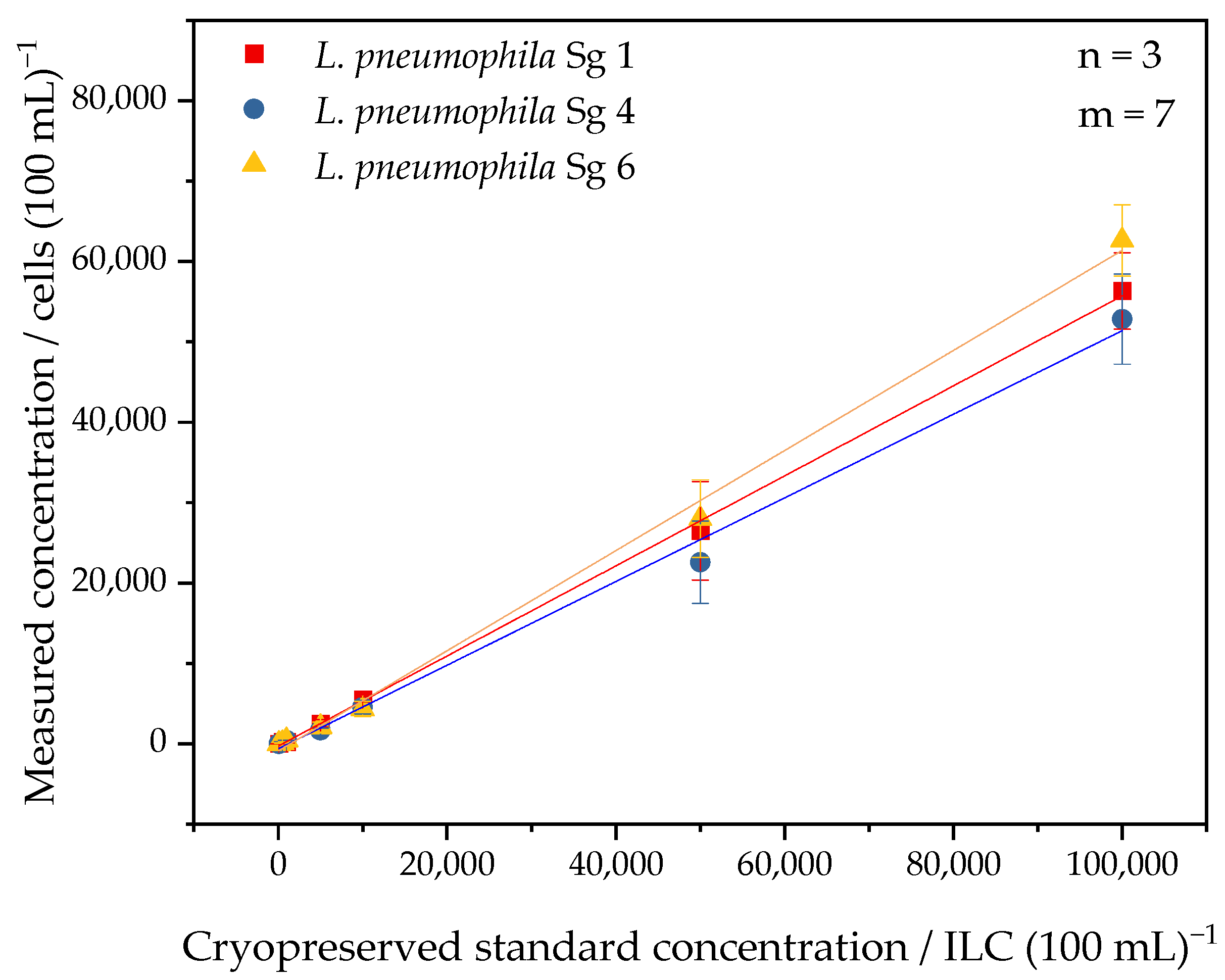Culture-Independent Quantification of Legionella pneumophila in Evaporative Cooling Systems Using Immunomagnetic Separation Coupled with Flow Cytometry
Abstract
1. Introduction
2. Materials and Methods
2.1. Chemicals and Materials
2.2. Preparation of Conditioned Cryopreserved Legionella Standards
2.3. Culture-Independent Quantification by the IMS-FCM Method
2.4. Process Water Analysis of Real ECS Samples
3. Results
3.1. Determining the Stability and Applicability of Cryopreserved Legionella Standards
3.2. Characterization of the IMS-FCM Method Using Cryopreserved Legionella Standards
3.3. Utilization of the IMS-FCM Method for the Analysis of Real Process Water
4. Discussion
5. Conclusions
Supplementary Materials
Author Contributions
Funding
Institutional Review Board Statement
Informed Consent Statement
Data Availability Statement
Acknowledgments
Conflicts of Interest
References
- Fields, B.S.; Benson, R.F.; Besser, R.E. Legionella and Legionnaires’ Disease: 25 Years of Investigation. Clin. Microbiol. Rev. 2002, 15, 506–526. [Google Scholar] [CrossRef]
- Gao, L.-Y.; Stone, B.J.; Brieland, J.K.; Kwaik, Y.A. Different Fates of Legionella pneumophila pmi and mil Mutants within Macrophages and Alveolar Epithelial Cells. Microb. Pathog. 1998, 25, 291–306. [Google Scholar] [CrossRef] [PubMed]
- Atlas, R.M. Legionella: From Environmental Habitats to Disease Pathology, Detection and Control. Environ. Microbiol. 1999, 1, 283–293. [Google Scholar] [CrossRef] [PubMed]
- Walser, S.M.; Gerstner, D.G.; Brenner, B.; Höller, C.; Liebl, B.; Herr, C.E.W. Assessing the Environmental Health Relevance of Cooling Towers—A Systematic Review of Legionellosis Outbreaks. Int. J. Hyg. Environ. Health 2014, 217, 145–154. [Google Scholar] [CrossRef] [PubMed]
- DIN EN ISO 11731:2017; Water Quality—Enumeration of Legionella. International Organization for Standardization: Geneva, Switzerland, 2017.
- Lucas, C.E.; Taylor, T.H.; Fields, B.S. Accuracy and Precision of Legionella Isolation by US Laboratories in the ELITE Program Pilot Study. Water Res. 2011, 45, 4428–4436. [Google Scholar] [CrossRef]
- García, M.T.; Jones, S.; Pelaz, C.; Millar, R.D.; Abu Kwaik, Y. Acanthamoeba polyphaga Resuscitates Viable Non-culturable Legionella pneumophila after Disinfection. Environ. Microbiol. 2007, 9, 1267–1277. [Google Scholar] [CrossRef] [PubMed]
- Allegra, S.; Berger, F.; Berthelot, P.; Grattard, F.; Pozzetto, B.; Riffard, S. Use of Flow Cytometry to Monitor Legionella Viability. Appl. Environ. Microbiol. 2008, 74, 7813–7816. [Google Scholar] [CrossRef] [PubMed]
- Oliver, J.D. Recent Findings on the Viable but Nonculturable State in Pathogenic Bacteria. FEMS Microbiol. Rev. 2010, 34, 415–425. [Google Scholar] [CrossRef]
- Cervero-Aragó, S.; Rodríguez-Martínez, S.; Puertas-Bennasar, A.; Araujo, R.M. Effect of Common Drinking Water Disinfectants, Chlorine and Heat, on Free Legionella and Amoebae-Associated Legionella. PLoS ONE 2015, 10, 1–18. [Google Scholar] [CrossRef]
- Ducret, A.; Chabalier, M.; Dukan, S. Characterization and Resuscitation of ‘Non-Culturable’ Cells of Legionella pneumophila. BMC Microbiol. 2014, 14, 1–10. [Google Scholar] [CrossRef]
- Lee, J.V.; Lai, S.; Exner, M.; Lenz, J.; Gaia, V.; Casati, S.; Hartemann, P.; Lück, C.; Pangon, B.; Ricci, M.L.; et al. An International Trial of Quantitative PCR for Monitoring Legionella in Artificial Water Systems: qPCR for Monitoring Legionella. J. Appl. Microbiol. 2011, 110, 1032–1044. [Google Scholar] [CrossRef]
- Keserue, H.; Baumgartner, A.; Felleisen, R.; Egli, T. Rapid Detection of Total and Viable Legionella pneumophila in Tap Water by Immunomagnetic Separation, Double Fluorescent Staining and Flow Cytometry. Microbial. Biotechnol. 2012, 5, 753–763. [Google Scholar] [CrossRef]
- Nocker, A.; Schulte-Illingheim, L.; Frösler, J.; Welp, L.; Sperber, O.; Hugo, A. Microbiological Examination of Water and Aerosols from Four Industrial Evaporative Cooling Systems in Regard to Risk of Legionella Emissions and Methodological Suggestions for Surveillance. Int. J. Hyg. Environ. Health 2020, 229, 113591. [Google Scholar] [CrossRef]
- Basiji, D.A.; Ortyn, W.E.; Liang, L.; Venkatachalam, V.; Morrissey, P. Cellular Image Analysis and Imaging by Flow Cytometry. Clin. Lab. Med. 2007, 27, 653–670. [Google Scholar] [CrossRef]
- Gruden, C.; Skerlos, S.; Adriaens, P. Flow Cytometry for Microbial Sensing in Environmental Sustainability Applications: Current Status and Future Prospects. FEMS Microbiol. Ecol. 2004, 49, 37–49. [Google Scholar] [CrossRef] [PubMed]
- Rajapaksha, P.; Elbourne, A.; Gangadoo, S.; Brown, R.; Cozzolino, D.; Chapman, J. A Review of Methods for the Detection of Pathogenic Microorganisms. Anal. The 2019, 144, 396–411. [Google Scholar] [CrossRef]
- Ihadjadene, Y.; Walther, T.; Krujatz, F. Optimized Protocol for Microalgae DNA Staining with SYTO9/SYBR Green I, Based on Flow Cytometry and RSM Methodology: Experimental Design, Impacts and Validation. Methods Protoc. 2022, 5, 76. [Google Scholar] [CrossRef]
- Boulos, L.; Prevost, M.; Barbeau, B.; Coallier, J.; Desjardins, R. LIVE/DEAD BacLight: Application of a New Rapid Staining Method for Direct Enumeration of Viable and Total Bacteria in Drinking Water. J. Microbiol. Methods 1999, 37, 77–86. [Google Scholar] [CrossRef]
- Schleich, C.; Chan, S.; Pullerits, K.; Besmer, M.D.; Paul, C.J.; Rådström, P.; Keucken, A. Mapping Dynamics of Bacterial Communities in a Full-Scale Drinking Water Distribution System Using Flow Cytometry. Water 2019, 11, 2137. [Google Scholar] [CrossRef]
- Gillespie, S.; Lipphaus, P.; Green, J.; Parsons, S.; Weir, P.; Juskowiak, K.; Jefferson, B.; Jarvis, P.; Nocker, A. Assessing Microbiological Water Quality in Drinking Water Distribution Systems with Disinfectant Residual Using Flow Cytometry. Water Res. 2014, 65, 224–234. [Google Scholar] [CrossRef] [PubMed]
- Imran, M.; Affandi, A.M.; Alam, M.M.; Khan, A.; Khan, A.I. Advanced Biomedical Applications of Iron Oxide Nanostructures Based Ferrofluids. Nanotechnol. 2021, 32, 422001. [Google Scholar] [CrossRef]
- Yáñez, M.A.; Carrasco-Serrano, C.; Barberá, V.M.V. Catalán Quantitative Detection of Legionella pneumophila in Water Samples by Immunomagnetic Purification and Real-Time PCR Amplification of the dotA Gene. Appl. Environ. Microbiol. 2005, 71, 3433–3441. [Google Scholar] [CrossRef]
- Ortí-Lucas, R.M.; Luciano, E. New Immunomagnetic Separation Method to Analyze Risk Factors for Legionella Colonization in Health Care Centres. J. Expo. Sci. Environ. Epidemiol. 2022, 32, 744–750. [Google Scholar] [CrossRef]
- Keserue, H.-A.; Cornillie, N.; Ehlert, A.-K.; Mills, D.C.; Morger, D.; Piffaretti, A.; Schaffhauser, D.F.; Schwyzer, I.I. Validation of the Legionella pneumophila SG1 DETECT Kit for Quantification of Legionella pneumophila Serogroup 1 Bacteria in Potable Waters, Process Waters, and Surface Waters: AOAC Performance Tested Method 052002. J. AOAC Int. 2021, 104, 776–789. [Google Scholar] [CrossRef] [PubMed]
- Füchslin, H.P.; Kötzsch, S.; Keserue, H.; Egli, T. Rapid and Quantitative Detection of Legionella pneumophila Applying Immunomagnetic Separation and Flow Cytometry. Cytometry A 2010, 77A, 264–274. [Google Scholar] [CrossRef] [PubMed]
- Heining, L.; Welp, L.; Hugo, A.; Elsner, M.; Seidel, M. Immunomagnetic Separation Coupled with Flow Cytometry for the Analysis of Legionella pneumophila in Aerosols. Anal. Bioanal. Chem. 2023, 415, 5139–5149. [Google Scholar] [CrossRef]
- DIN EN ISO 11133:2020; Microbiology of Food, Animal Feed and Water—Preparation, Production, Storage and Performance Testing of Culture Media. International Organization for Standardization: Geneva, Switzerland, 2020.
- Yu, V.L.; Plouffe, J.F.; Pastoris, M.C.; Stout, J.E.; Schousboe, M.; Widmer, A.; Summersgill, J.; File, T.; Heath, C.M.; Paterson, D.L.; et al. Distribution of Legionella Species and Serogroups Isolated by Culture in Patients with Sporadic Community-Acquired Legionellosis: An International Collaborative Survey. J. Infect. Dis. 2002, 186, 127–128. [Google Scholar] [CrossRef] [PubMed]
- Giulio, B.D.; Orlando, P.; Barba, G.; Coppola, R.; Rosa, M.D.; Sada, A.; Prisco, P.P.D.; Nazzaro, F. Use of Alginate and Cryo-Protective Sugars to Improve the Viability of Lactic Acid Bacteria after Freezing and Freeze-Drying. World. J. Microbiol. Biotechnol. 2005, 21, 739–746. [Google Scholar] [CrossRef]
- Kim, B.R.; Anderson, J.E.; Mueller, S.A.; Gaines, W.A.; Kendall, A.M. Literature Review—Efficacy of Various Disinfectants against Legionella in Water Systems. Water Res. 2002, 36, 4433–4444. [Google Scholar] [CrossRef]
- Alleron, L.; Merlet, N.; Lacombe, C.; Frère, J. Long-Term Survival of Legionella pneumophila in the Viable But Nonculturable State After Monochloramine Treatment. Curr. Microbiol. 2008, 57, 497–502. [Google Scholar] [CrossRef]
- Hahm, B.-K.; Bhunia, A.K. Effect of Environmental Stresses on Antibody-Based Detection of Escherichia coli O157:H7, Salmonella enterica Serotype Enteritidis and Listeria monocytogenes. J. Appl. Microbiol. 2006, 100, 1017–1027. [Google Scholar] [CrossRef] [PubMed]
- James, B.W.; Mauchline, W.S.; Dennis, P.J.; Keevil, C.W. A Study of Iron Acquisition Mechanisms of Legionella pneumophila Grown in Chemostat Culture. Curr. Microbiol. 1997, 34, 238–243. [Google Scholar] [CrossRef] [PubMed]
- Garduño, R.A.; Garduño, E.; Hiltz, M.; Hoffman, P.S. Intracellular Growth of Legionella pneumophila Gives Rise to a Differentiated Form Dissimilar to Stationary-Phase Forms. Infect. Immun. 2002, 70, 6273–6283. [Google Scholar] [CrossRef] [PubMed]
- Liao, C.-H.; Shollenberger, L.M. Survivability and Long-Term Preservation of Bacteria in Water and in Phosphate-Buffered Saline. Lett. Appl. Microbiol. 2003, 37, 45–50. [Google Scholar] [CrossRef]
- Ahmed, S.; Liwak-Muir, U.; Walker, D.; Zoldowski, A.; Mears, A.; Golovan, S.; Mohr, S.; Lem, P.; Harder, C. Validation and In-Field Testing of a New on-Site qPCR System for Quantification of Legionella pneumophila According to ISO/TS 12869:2012 in HVAC Cooling Towers. J. Water Health 2019, 17, 237–253. [Google Scholar] [CrossRef]
- Guerrieri, E.; Bondi, M.; Sabia, C.; De Niederhäusern, S.; Borella, P.; Messi, P. Effect of Bacterial Interference on Biofilm Development by Legionella pneumophila. Curr. Microbiol. 2008, 57, 532–536. [Google Scholar] [CrossRef]




| Sample Concentration (ILC/100 mL) | Repeatability (%) |
|---|---|
| 102 | 466.5 ± 7.2 |
| 5 × 102 | 166.3 ± 15.9 |
| 103 | 86.7 ± 19.4 |
| 5 × 103 | 89.0 ± 15.0 |
| 104 | 91.6 ± 4.6 |
| 5 × 104 | 84.5 ± 19.3 |
| 105 | 89.3 ± 7.5 |
| Parameters | L. pneumophila Sg 1 | L. pneumophila Sg 4 | L. pneumophila Sg 6 |
|---|---|---|---|
| Recovery | 56% | 52% | 62% |
| LoD (ILC/100 mL) | 100.0 | 105.3 | 88.0 |
| LoQ (ILC/100 mL) | 333.4 | 351.1 | 293.4 |
| Linear Regression | R2 = 0.9993 | R2 = 0.9953 | R2 = 0.9972 |
| Sample Concentration (ILC/100 mL) | Repeatability (%) | ||
|---|---|---|---|
| L. pneumophila Sg 1 | L. pneumophila Sg 4 | L. pneumophila Sg 6 | |
| 103 | 86.7 ± 19.4 | 117.0 ± 9.8 | 115.0 ± 27.9 |
| 104 | 91.6 ± 4.6 | 76.3 ± 12.9 | 80.7 ± 15.1 |
| 105 | 89.3 ± 7.5 | 83.8 ± 8.8 | 99.2 ± 7.0 |
Disclaimer/Publisher’s Note: The statements, opinions and data contained in all publications are solely those of the individual author(s) and contributor(s) and not of MDPI and/or the editor(s). MDPI and/or the editor(s) disclaim responsibility for any injury to people or property resulting from any ideas, methods, instructions or products referred to in the content. |
© 2024 by the authors. Licensee MDPI, Basel, Switzerland. This article is an open access article distributed under the terms and conditions of the Creative Commons Attribution (CC BY) license (https://creativecommons.org/licenses/by/4.0/).
Share and Cite
Streich, P.; Redwitz, J.; Walser-Reichenbach, S.; Herr, C.E.W.; Elsner, M.; Seidel, M. Culture-Independent Quantification of Legionella pneumophila in Evaporative Cooling Systems Using Immunomagnetic Separation Coupled with Flow Cytometry. Appl. Microbiol. 2024, 4, 284-296. https://doi.org/10.3390/applmicrobiol4010019
Streich P, Redwitz J, Walser-Reichenbach S, Herr CEW, Elsner M, Seidel M. Culture-Independent Quantification of Legionella pneumophila in Evaporative Cooling Systems Using Immunomagnetic Separation Coupled with Flow Cytometry. Applied Microbiology. 2024; 4(1):284-296. https://doi.org/10.3390/applmicrobiol4010019
Chicago/Turabian StyleStreich, Philipp, Johannes Redwitz, Sandra Walser-Reichenbach, Caroline E. W. Herr, Martin Elsner, and Michael Seidel. 2024. "Culture-Independent Quantification of Legionella pneumophila in Evaporative Cooling Systems Using Immunomagnetic Separation Coupled with Flow Cytometry" Applied Microbiology 4, no. 1: 284-296. https://doi.org/10.3390/applmicrobiol4010019
APA StyleStreich, P., Redwitz, J., Walser-Reichenbach, S., Herr, C. E. W., Elsner, M., & Seidel, M. (2024). Culture-Independent Quantification of Legionella pneumophila in Evaporative Cooling Systems Using Immunomagnetic Separation Coupled with Flow Cytometry. Applied Microbiology, 4(1), 284-296. https://doi.org/10.3390/applmicrobiol4010019






